
Tamiya 1/35 Sd.kfz.9 18T FAMO Halftrack & Trumpeter 21cm Mörser 18
| KIT #: | 35239/02314 |
| PRICE: | $65.00/$45.00 SRP |
| DECALS: | Four options/No options |
| REVIEWER: | Blair Stewart |
| NOTES: |
Tamiya 35186 German Fuel Drum Set; Trumpeter 06610 21cm ammo pack;
assorted items from the armor scrap box |

| HISTORY |
FAMO – The Sd.Kfz. 9 or "FAMO" was a large German half-track that the Germans
used widely in World War II, and the heaviest half-track vehicle of any type
built in quantity in Nazi Germany during the war years. It mainly served as a
prime mover for very heavy towed guns and as a tank recovery vehicle. Germany
produced about 2,500 FAMOs between 1938 and 1945.
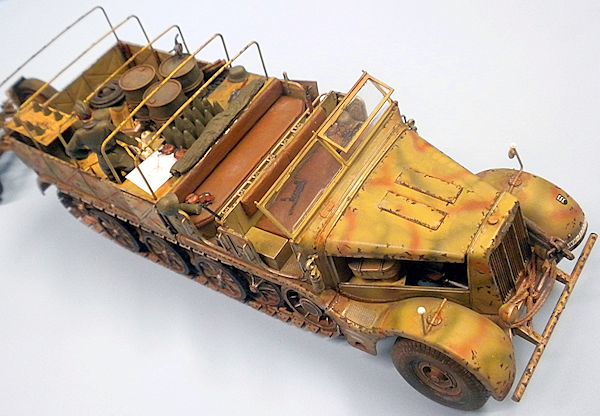 steering system was set up so that
shallow turns used only the wheels, but brakes could be applied to the tracks
the further the steering wheel was turned. The drive sprocket, like all German
halftracks, had rollers rather than the more common teeth used on other
vehicles. The rear suspension consisted of six double sets of overlapping,
interleaved road wheels mounted on swing arms that were sprung by torsion bars.
An idler wheel, mounted at the rear of the vehicle, controlled track tension.
The front wheels had leaf springs and shock absorbers.
steering system was set up so that
shallow turns used only the wheels, but brakes could be applied to the tracks
the further the steering wheel was turned. The drive sprocket, like all German
halftracks, had rollers rather than the more common teeth used on other
vehicles. The rear suspension consisted of six double sets of overlapping,
interleaved road wheels mounted on swing arms that were sprung by torsion bars.
An idler wheel, mounted at the rear of the vehicle, controlled track tension.
The front wheels had leaf springs and shock absorbers.
The Sd.Kfz. 9
had a towing capacity of 28 long tons (28 long tons; 31 short tons). This was
adequate for medium tanks like the Panzer IV, but two or sometimes three or four
Famos were necessary to tow heavier vehicles like the Tiger I, Panther or King
Tiger.
Ernst
Kniepkamp of the German Military Automotive Department did the preliminary
design of all the German half-tracks of the early part of the war before the
Nazis came to power in 1933. His designs were then turned over to commercial
firms for development and testing. Fahrzeug- und Motorenbau GmbH (FAMO) of
Breslau received the contract for the 18 ton heavy towing, tracked vehicle. FAMO
completed its first prototype in 1936. The first prototype had a 200 horsepower
Maybach HL 98 TUK engine and was only (25 ft) long. The
second prototype model
appeared in 1938, but differed only in detail from its predecessor.
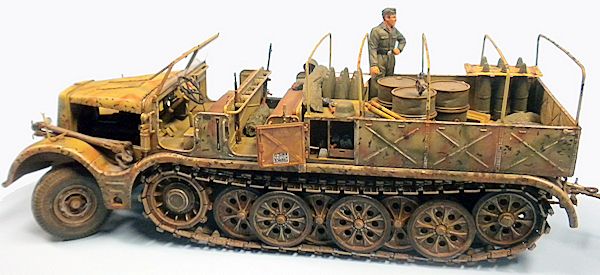 21cm Mörser 18 – The Germans designed the Mörser 18 to replace
the obsolescent World War I-era 21cm Mörser 16. While the gun design itself was
nothing innovative, the same cannot be said for the “elaborate” carriage. It was
one of the first weapons, if not the first in quantity production, that used the
interesting dual-recoil system. The barrel recoiled normally in its cradle, but,
in addition, the whole top carriage, which carried the barrel and its cradle,
recoiled across the main part of the carriage. This system damped out the recoil
forces and created a very steady firing platform. This carriage was also used
for the 17 cm Kanone 18 in and the 15 cm Schnelladekanone C/28.
21cm Mörser 18 – The Germans designed the Mörser 18 to replace
the obsolescent World War I-era 21cm Mörser 16. While the gun design itself was
nothing innovative, the same cannot be said for the “elaborate” carriage. It was
one of the first weapons, if not the first in quantity production, that used the
interesting dual-recoil system. The barrel recoiled normally in its cradle, but,
in addition, the whole top carriage, which carried the barrel and its cradle,
recoiled across the main part of the carriage. This system damped out the recoil
forces and created a very steady firing platform. This carriage was also used
for the 17 cm Kanone 18 in and the 15 cm Schnelladekanone C/28.
| THE KIT |
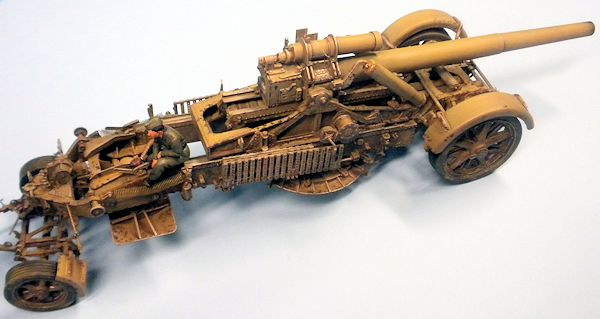 I have always enjoyed war movies in which real period
equipment is used, and the first time I saw “The Dirty Dozen” I was fascinated
by the large German halftrack used in the final scenes. I was convinced at one
time that the halftrack was indeed a FAMO. Alas: dreams are inevitably dashed.
The vehicle was actually a Sd.kfz.8 12 ton Halftrack, and my image of war movies
was forever destroyed (never mind the simple fact that, if one truly wanted to
escape a rather dire situation, and do so quickly, one would definitely NOT pin
one’s hopes on a 12 ton, probably governor-limited, halftrack). Being the
largest halftrack that ever existed, I have longed to build a 1/35 model of this
beast, so when Tamiya released their beautiful kit in December, 1999, I began
plotting the day when I could add one to my collection and eventually assemble
it. But the initial price deterred me for several years – thank goodness for
EBay! I found one for a somewhat better price, purchased it, and put it in the
stash for a rainy day.
I have always enjoyed war movies in which real period
equipment is used, and the first time I saw “The Dirty Dozen” I was fascinated
by the large German halftrack used in the final scenes. I was convinced at one
time that the halftrack was indeed a FAMO. Alas: dreams are inevitably dashed.
The vehicle was actually a Sd.kfz.8 12 ton Halftrack, and my image of war movies
was forever destroyed (never mind the simple fact that, if one truly wanted to
escape a rather dire situation, and do so quickly, one would definitely NOT pin
one’s hopes on a 12 ton, probably governor-limited, halftrack). Being the
largest halftrack that ever existed, I have longed to build a 1/35 model of this
beast, so when Tamiya released their beautiful kit in December, 1999, I began
plotting the day when I could add one to my collection and eventually assemble
it. But the initial price deterred me for several years – thank goodness for
EBay! I found one for a somewhat better price, purchased it, and put it in the
stash for a rainy day.
Enter Trumpeter, the upstart Chinese would be heir to the
Tamiya throne. As they released kit after kit, it wasn’t long before they
entered the realm of the heretofore never released 1/35 subjects, such as the
21cm Mörser 18 artillery piece. At last, I had the perfect complement to the
FAMO, so I decided to embark on a project to build these two kits together as a
“single” model (in fact, the Trumpeter box art appears to depict a FAMO towing
the Mörser, so this was even more incentive for me to link the two together in a
protracted build session).
Tamiya FAMO – In keeping with Tamiya’s precision molding,
there is not a hint of flash on any of the parts in this kit. Molded in Tamiya’s
traditional tan colored plastic, the kit consists of some 402 parts on 11 tan
sprues, three brown sprues containing the 196 parts for the two part track
links, three soft rubber tires, a small acetate clear sheet for the windshield,
seven poly caps, and a length of thread for the tow cables. The chassis is
molded as a single unit, with separate assemblies for the torsion bar covers and
transmission. The winch assembly, which mounts under the chassis, is made to
pivot so it can reel out the attached tow cable made from the included thread
and a plastic tow cable end loop.
 While I have grown to dread individual track links, I must say
that the ones for this kit are a pleasant surprise: when assembled correctly,
the tracks actually work and are completely flexible just like the real thing -
a great bit of kit engineering on the part of Tamiya. The advantage to this is
that, once assembled, the tracks can be rolled onto the drive sprockets and
idlers and then their two ends linked together, and this is a great innovation
over individual link tracks that are not flexible when assembled.
While I have grown to dread individual track links, I must say
that the ones for this kit are a pleasant surprise: when assembled correctly,
the tracks actually work and are completely flexible just like the real thing -
a great bit of kit engineering on the part of Tamiya. The advantage to this is
that, once assembled, the tracks can be rolled onto the drive sprockets and
idlers and then their two ends linked together, and this is a great innovation
over individual link tracks that are not flexible when assembled.
In addition to the working winch, the kit includes a workable
tow par that can be used to attach almost any German vehicle to the FAMO. It
even includes a scale locking pin for securing the vehicle to the tow bar.
The engine compartment includes a reasonably detailed Maybach
engine that could be super detailed by those that are so inclined. The dual
exhaust system is nicely molded and runs the length of the vehicle, exiting the
back.
The kit includes decals for four different vehicles with color
schemes running from panzer gray to German yellow to German yellow with a brown
and green camouflage pattern. Tamiya breaks its 20 page instructions down into
32 illustrated steps, and they are excellent.
Trumpeter Mörser 18 – When I decided to purchase this kit, I
had no idea what I was in for: another kit with over 400 parts, many of them
very small and finely detailed. I have to say it is one of the more complex kits
I have built to date, and the small plastic parts, while adding to the detail,
also add time and tedium to the overall assembly process.
 The 400 plus plastic parts, which are molded in light gray
styrene, are contained on 11 sprues. As in the Tamiya kit, the parts are
virtually flash free and very finely detailed. In addition, the kit contains two
large and two small nicely molded rubber tires for the chassis. In keeping with
the multi-media trend of today’s kits, the kit also contains two metal springs,
two brass tubes, and one fret of photo-etched parts. The kit contains no clear
parts or decals.
The 400 plus plastic parts, which are molded in light gray
styrene, are contained on 11 sprues. As in the Tamiya kit, the parts are
virtually flash free and very finely detailed. In addition, the kit contains two
large and two small nicely molded rubber tires for the chassis. In keeping with
the multi-media trend of today’s kits, the kit also contains two metal springs,
two brass tubes, and one fret of photo-etched parts. The kit contains no clear
parts or decals.
There are several plastic parts that are not used in the kit’s
construction, and these can create some confusion during the assembly process if
one is not careful. One trick to consider is removing these parts prior to
construction so that you can actually see when a sprue is complete or empty
(can’t tell you how many times I’ve had to fish a tossed sprue out of the
garbage can because I “thought” it was finished, or how many parts I’ve had to
make from scratch because I either lost them, broke them, or accidentally threw
them away).
Finally, the kit’s 24 page instructions booklet contains 25
separate assembly steps. Trumpeter’s assembly instructions approach of
indicating where a part should go via an arrow from the part to its location on
an assembly can be very misleading at times, and one must sometimes study
additional or later steps in the instructions to really understand where a
particular part is to be placed. A
final, nice touch is a full color painting and marking guide, which provides
three views of the model and a complete model paint reference.
| CONSTRUCTION |
Tamiya FAMO – I started by assembling the Maybach HL108
engine, which one assembles in four sub-steps. After assembling the engine, I
chose to not paint it and brush paint it later when I glued it to the chassis,
but one can just as well airbrush it and set it aside for later attaching to the
frame. The next step involved assembling the chassis and mounting axles and
other items to the chassis and frame.
In step three, I assembled the G65VL230 transmission and the
air tank and set them aside. In step four, I glued all of the torsion bars to
the chassis and mounted the engine, transmission, and air tank on the chassis
frame.
In step five, I assembled all the idler and road wheels and
the right and left drive sprockets. The drive sprockets wedge a poly cap in
between the inner and outer assembly so that the sprockets will rotate on their
mounting axles, and this is a very useful feature when one goes to put the
tracks on the vehicle.
I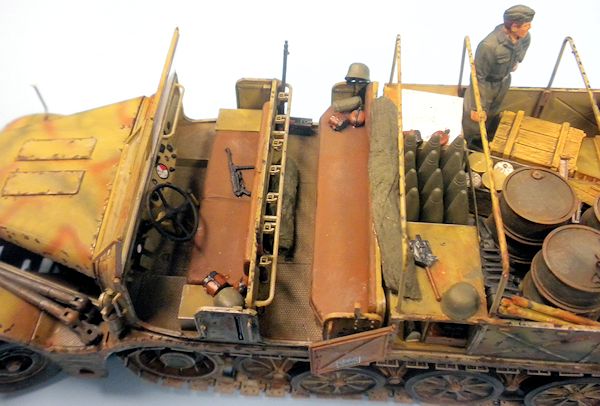 n steps 6 and 7, I assembled the left and right exhaust
systems and mounted them to the frame. I also installed the road wheels, idlers,
and drive sprockets at this point. Step 8 involves the assembly of the five part
front wheels. I left the tires off for later installation after painting the
vehicle.
n steps 6 and 7, I assembled the left and right exhaust
systems and mounted them to the frame. I also installed the road wheels, idlers,
and drive sprockets at this point. Step 8 involves the assembly of the five part
front wheels. I left the tires off for later installation after painting the
vehicle.
In step 9, I assembled the well-detailed front axle and
suspension system. This involves 11 finely detailed parts. I set this aside for
later attachment to the chassis frame.
Step 10 guides you through the assembly of the intricate
coupler (hitch) assembly and towrope guide for the rear of the vehicle. The
coupler assembly includes 10 parts with a poly cap to allow the assembly to be
removed from the vehicle. The hitch transition has movable parts to allow the
coupler to be adjusted to various heights and orientations, depending on what
one wants to hitch to the FAMO.
I then glued the front suspension (Step 11) to the chassis,
popped on the coupler assembly, and installed the remaining road wheels. In
steps 12-13, I assembled the winch and wound the included rope, which simulates
a steel tow cable, around the winch’s take-up spool. I then attached the take-up
spool via a poly cap to the winch itself and glued the complete mechanism to the
underside of the chassis. I then
attached the steering box and arm to the front of the chassis.
In step 14, I began assembling the tracks. These are composed
of 47 finely detailed links that are held together by the road pads, which are
glued on top of the link connection. If done right, this results in a neat
articulating track assembly - a coup, in my opinion, for Tamiya kit engineering.
I set both tracks aside for later painting.
Steps 15 and 16 involved assembling the grille and radiator
and front headlights, and then gluing these and the front bumper to the front
fender assembly. I also assembled the driving compartment floor. In steps 17-19,
I completed the intricate assembly of the crew cabin and instrument panel,
finishing this by assembling the steering wheel and column into the crew cabin.
In step 20, I attached the front fender assembly, the crew cab, and the lower
engine compartment side covers to the chassis.
Steps 21-22 involve assembly of the air cleaner and the
windshield, which includes a driver’s windshield that can be displayed open or
closed. I then attached the two fender side platforms to the fender, installed
the air cleaner in the engine compartment, and glued the hood support rods to
the firewall and radiator.
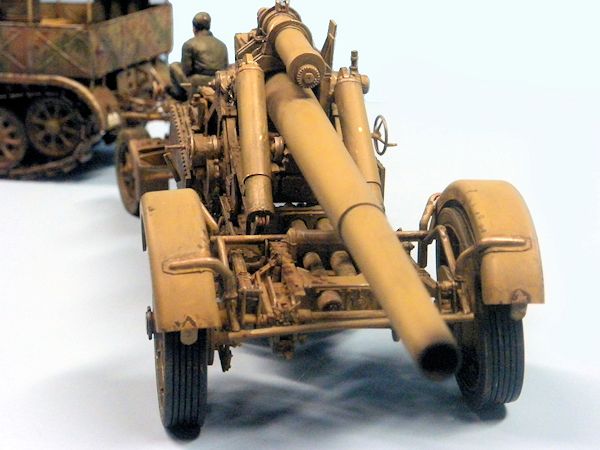 The next major assembly was the rear cargo or flatbed assembly
(Steps 23-25). This goes together flawlessly, but I didn’t think ahead enough
when I decided I would wait to install the spar tire and its holder (trying to
plan ahead for painting). I later found out what a problem it was to try and
install the spare tire and holder after I had attached the cargo bay to the
chassis. In step 26, I glued the flatbed to the chassis,
and this sealed my fate
for the later installation of the spare tire and holder (oh well: live and
learn).
The next major assembly was the rear cargo or flatbed assembly
(Steps 23-25). This goes together flawlessly, but I didn’t think ahead enough
when I decided I would wait to install the spar tire and its holder (trying to
plan ahead for painting). I later found out what a problem it was to try and
install the spare tire and holder after I had attached the cargo bay to the
chassis. In step 26, I glued the flatbed to the chassis,
and this sealed my fate
for the later installation of the spare tire and holder (oh well: live and
learn).
Step 27 covers the assembly, posing and painting of the
included figures. I only opted to use one of the kit’s figures: a standing
figure in coveralls. In step 28, I mounted all of the grab handles to the body
and the position markers/mirror to the front fenders. Step 29 involved the
assembly of the various toolboxes and jack that comes with the kit. The
toolboxes can be mounted inside of the side storage areas or in the flatbed.
Finally, in step 30 I assembled the finely detailed draw bar. I planned
originally to stow this in the flatbed cargo compartment, but, after seeing
several examples of assembled FAMOs on the web, I decided to mount it on the
front fender. This in turn gave me more room in the cargo bed for additional
tools, equipment, and sundry other items.
Trumpeter Mörser 18 – As I stated earlier, the idea of
tackling this kit was daunting to say the least, but I was determined to see it
through, so I dove in at steps 1-2: the assembly of the gun carriage’s main
frame. As a matter of fact, the carriage itself is not completed until step 9
and probably some 50-60 parts later. Many of these parts are very petite, and
require considerable care to glue to the carriage assembly. At step 9, one must
decide on how the model will be displayed; i.e., in the combat or travel mode.
Since I was going to display the gun being pulled by the FAMO, I opted for the
travel mode. A caution: whichever mode you choose, make sure you thoroughly
study the instructions, the box art, and the coloring guide, since the
instructions alone are a little fuzzy with regards to positions of various
components when in the combat versus travel mode. I had a hard time with this,
and found myself at later steps realizing I had glued some pieces in the wrong
orientation, requiring me to “unglue” them and reattach these properly.
In step 10, I assembled the movable yoke to which the rear
road wheels are attached later in the assembly. In step 11, I used the two
supplied steel springs to “articulate” the yoke. I later discovered these to not
be strong enough to hold the yoke in the correct travel position, and I ended up
drilling a small hole in the side of the carriage and then another in the yoke
arm, and used a small steel pin to hold it in its proper traveling position.
Steps 12-13 are where I first got into trouble regarding
orientation of components; namely, the positioning of the treadle plates for the
travel mode. The instructions seem to indicate that these are deployed or down
in the travel mode, but both the box art and the coloring guide plainly show
them stowed in the up position for the travel mode. Unfortunately, I did not
follow my own advise of careful study of the instructions, and later had to
correct this mistake (had I done so, I would have noted that step 25 – the last
step - shows the proper orientation
of the treadles for traveling).

In step 14, more components are added to the complex main
carriage, and the large wheels are assembled here. I left the rubber tires off
to accommodate painting.
Steps 15-19 involve assembly of the gun and its main carriage
or cradle. Both are very detailed sub assemblies and look great when completed.
I have to say I ran into a slight problem at step 19: the assembly of the two
pistons that elevate and lower the gun. The outer housing is brass, while the
inner pistons are two plastic parts that are glued together. When I glued the
pistons together, I found they did not fit very well into the brass housings, so
I had to sand, fit check, and sand these pieces until they would move freely
within the brass housings. In the process of installing these and checking them
on the gun, I managed to break off one of the delicate “bumps” that allows the
piston to rotate on its axis when the gun
is elevated and depressed, and that
became a continual hassle until I finally placed the gun in its display
configuration (in hindsight, I could have just glued the pistons in their down
position for the travel mode, but I have to admit it is kind of neat to have
them working like the real thing!).
After assembling the gun and its cradle/carriage, I started
the front axle and suspension for the smaller road wheels (Step 20). Here, I
encountered the first of the dreaded photo etch (PE) parts, and they were a
doozie, requiring me to bend the PE parts in several different orientations.
Given my lack of patience, I gave up after numerous unsuccessful attempts to
bend one of the PE parts, and decided to leave them off. This decision was
supported by the rationalization that these particular parts were on the inside
of the suspension system and would not be missed or seen by the “less than
casual” observer.
In step 21, I assembled the small road wheels and the nicely
detailed tow bar, which I did not glue to the front suspension, as it is made to
articulate (a nice feature when mating the gun carriage to a vehicle like the
FAMO).
Steps 22-23 involved attaching more PE for the rear wheels and
nice PE parts that go on the fenders. I then mounted the two smaller fenders to
the rear suspension and the larger two onto the main gun carriage. Finally, in
step 24, I mounted the gun and its cradle/carriage onto the large road carriage.
I did not glue the gun to the road carriage, and this aids a lot in the painting
process, plus provides the option to take the gun off the travel carriage if one
later chooses to do so.
| COLORS & MARKINGS |
Once I assembled both kits, I moved to the paint booth (or
basement, as it really is). For the FAMO, I had decided on the color scheme of
the 237 StuG Brigade in Russia, 1943, consisting of dark yellow with red brown
and dark green thin stripes. For the Mörser 18, I chose a basic dark yellow. I
intended to weather both models heavily after completing the painting process. I
also chose to use all Tamiya paints for the vehicles, but, of course, thinned
with lacquer thinner instead of the safer thinning solutions (like water!).
Again, my old habits die hard, and I have been using lacquer thinner as a
universal thinner for some 40 years now, and I guess I am addicted to it (and,
yes, you can thin acrylic paints with it). The vehicle colors, then, were Tamiya
XF-60, Dark Yellow, XF-64, Red Brown, and XF-61, Dark Green.
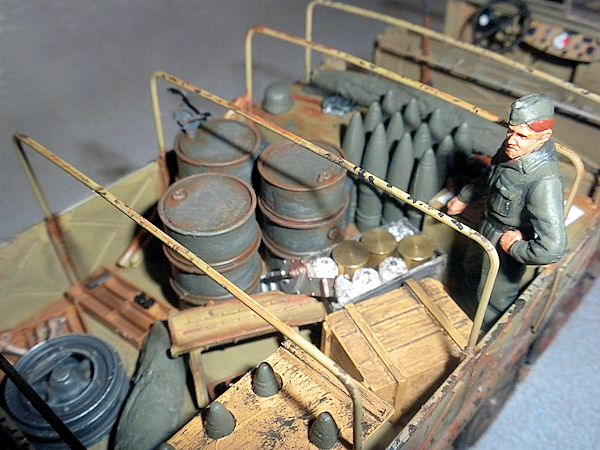 For both
models, I chose to employ the “color modulation” painting technique. I describe
this technique in my earlier build of
Dragon's Elefant with Zimmerit.
It is essentially a technique to provide gradation in the vehicle’s color by
applying three main levels of color - light, medium, and dark. It also requires
mixing several different shades of paints, so make sure you have some spare
mixing bottles handy.
For both
models, I chose to employ the “color modulation” painting technique. I describe
this technique in my earlier build of
Dragon's Elefant with Zimmerit.
It is essentially a technique to provide gradation in the vehicle’s color by
applying three main levels of color - light, medium, and dark. It also requires
mixing several different shades of paints, so make sure you have some spare
mixing bottles handy.
After spraying the basic dark yellow color schemes with my
faithful Paasche HS single action airbrush, I used an Iwata Eclipse HP-CS
gravity feed double action brush to carefully paint the brown and green camo
stripes on the FAMO. I then sprayed the FAMO tracks with some old Pactra steel
that I have had for more than 30 years. For all other items requiring painting,
I brush painted these using a combination of Model Masters and hobby acrylic
paints, including Vallejo’s Model Color #70-830 German Field Gray for the
figures’ uniforms and various pieces of equipment such as helmets that I would
later place in and on the FAMO.
There are only decals for the FAMO, and I used the kit
supplied decals to model the Russian front vehicle. Since the markings are
somewhat scant for these vehicles, rather than coat the entire model with a
gloss coat, I chose to place each decal in a puddle of Future Floor Wax. This
works quite well, and avoids having to apply an overall gloss coat followed by a
flat coat.
Weathering – for both models, I used a variety of weathering
techniques. First, I applied a thin dark acrylic wash, cut with water, over each
model to bring out the various highlights. I was careful to wipe up any excess
with a Q-tip. After I was satisfied with the wash, I moved to dry brushing each
model with Testors Rust (although this is more like a brown color) in places
where rust would normally tend to form. I then dry brushed a light tan acrylic
to simulate dust over both models, particularly on the wheels.
The most tedious weathering I did was the addition of paint
chips to both models. I did this using dark brown acrylic paint and a very fine
paintbrush to paint every paint chip. This is extremely time-consuming, but, if
done correctly, very rewarding in terms of achieving a very realistically
weathered model. I then ground up some light tan artist’s chalk and brushed this
on the model for additional weathering. The final weathering touch was the use
of a Prismacolor Metallic Silver pencil to highlight worn steel edges on both
models.
| FINAL CONSTRUCTION |
The FAMO is a great kit by itself,
but the huge cargo bay and crew compartment cry out for accessories, so I
started looking for things to fill add to both. First, since this FAMO is
hauling a 21cm artillery piece, I needed artillery shells, casings and powder
bags. After visiting the web, I discovered that Trumpeter makes a 21cm ammo
accessory kit (06610) for the Mörser
18, consisting of not only plastic rounds but also brass shells and casings. The
next problem was that one can’t just toss artillery shells in the back of a
FAMO: they need to be secured in some fashion for stowage. So here I went two
ways: first, I scratch built a
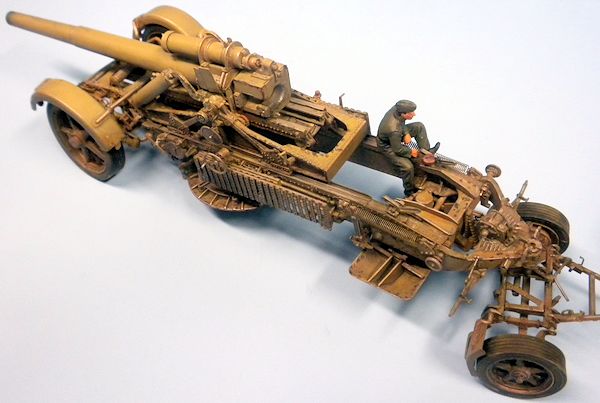 wooden ammo crate out of sheet styrene for six
shells (note: I have no idea whether this is accurate for the period – I just
happened to see such a crate in a web search, and decided that it made since for
large shells like these, so built it. I think it looks pretty neat, even if it
isn’t period-correct).
wooden ammo crate out of sheet styrene for six
shells (note: I have no idea whether this is accurate for the period – I just
happened to see such a crate in a web search, and decided that it made since for
large shells like these, so built it. I think it looks pretty neat, even if it
isn’t period-correct).
I then decided to stash 9 additional rounds in the cargo bay
space between the two side tool compartments. I installed a thin piece of PE
across the open space to simulate some type of restraining bar that might be
used to keep the shells from rattling around in the FAMO while underway. After a
lengthy search of the web, I decided to paint these shells German field gray,
which seemed to be the most consistent color in artillery round references I was
able to find for 21cm German artillery rounds.
I also needed a box for the powder bags and shell casings, so
I again scratch built one out of sheet styrene and brush painted it to simulate
wood.
Next, I assembled, painted and weathered drums and jerry cans
from the Tamiya German fuel drum set (35186) and set these aside. I added a
Mauser KAR-98 rifle and a MG-34 with ammo box to the back seat of the crew
compartment, plus placed an MP-40 on the driver’s seat. I painted and installed
various pieces of German equipment around the vehicle. I placed the spare wheel
from the FAMO kit in the cargo compartment and a number of tools, D rings, and
the shell loading device from the Mörser in there as well.
I then soaked some pieces of Kleenex in a diluted white glue
solution and rolled these up to simulate tarps. After these dried, I painted
them and then placed them on the vehicle. The final touch was a topographical
map I got from the web and reduced to scale size on my computer/printer.
The final task
was to paint the two figures: one from the FAMO kit that would be in the cargo
bay, and a sitting figure I had in the spares box to go on the Mörser 18.
| CONCLUSIONS |
 Well, after almost 1,000 parts, I can truly say this was quite
an accomplishment for this old glue head. When I started this project, I didn’t
think I would ever get to the finish, but persistence paid off. Both of these
kits are outstanding in terms of their detail, molding and assembly, and I think
they look great once they have been assembled. The Mörser 18 is a little more
tedious/complex than the FAMO due to the larger number of very small parts, and
the Trumpeter instructions are not quite as good as the Tamiya instructions.
Both kits present the modeler with a host of options in terms of display,
settings and dioramas. I highly recommend both kits to armor modelers,
especially those with experience in building today’s multi-media armor kits.
Well, after almost 1,000 parts, I can truly say this was quite
an accomplishment for this old glue head. When I started this project, I didn’t
think I would ever get to the finish, but persistence paid off. Both of these
kits are outstanding in terms of their detail, molding and assembly, and I think
they look great once they have been assembled. The Mörser 18 is a little more
tedious/complex than the FAMO due to the larger number of very small parts, and
the Trumpeter instructions are not quite as good as the Tamiya instructions.
Both kits present the modeler with a host of options in terms of display,
settings and dioramas. I highly recommend both kits to armor modelers,
especially those with experience in building today’s multi-media armor kits.
| REFERENCES |
June 2013
If you would like your product reviewed fairly and fairly quickly, please contact the editor or see other details in the Note to Contributors.